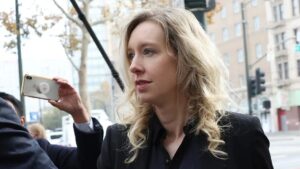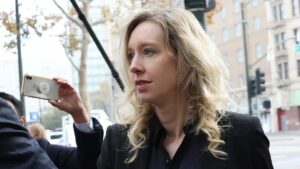The 38-year-old entrepreneur claimed to have developed a revolutionary machine for performing blood tests. The scam was exposed in 2015.
 Elizabeth Holmes, on November 18, 2022 in San José (United States). (JUSTIN SULLIVAN / GETTY IMAGES NORTH AMERICA / AFP)
Elizabeth Holmes, on November 18, 2022 in San José (United States). (JUSTIN SULLIVAN / GETTY IMAGES NORTH AMERICA / AFP)
“I am devastated by my failures.” Former Silicon Valley star Elizabeth Holmes was sentenced Friday, November 18, to just over 11 years in prison for fraud in the management of her start-up Theranos, which promised a revolution in blood tests. “I take, before you, my responsibilities for Theranos. I loved Theranos. It was my life’s work,” she told the hearing, sobbing, just before the sentencing.
The accused, pregnant, has until April 27 to begin her sentence, said Judge Edward Davila, who presided over the trial of the entrepreneur, completed in January. He found her guilty of lying to investors about the real progress of her business and demanded 15 years in prison against the 38-year-old former leader.
Judge Davila also wanted her to return $800 million to her victims. The amount she will ultimately have to repay to investors will be decided at a later date, the magistrate said.
Leading Supporters
At just 19 years old, Elizabeth Holmes founded Theranos in 2003, on a tantalizing promise: diagnostic tools faster and cheaper than those of traditional laboratories. With the help of a very worked story, she had managed in a few years to gain the confidence of luminaries and to raise funds from prestigious investors. In the early 2010s, she notably sported a black turtleneck sweater in explicit reference to the founder of Apple, Steve Jobs, to whom she was constantly compared.
In addition to the support of prestigious entrepreneurs, she had also won the confidence of political figures, such as ex-Secretary of State Henry Kissinger, former Minister of Defense James Mattis or media magnate Rupert Murdoch, who invests more of 100 million dollars (88 million euros) in Theranos.
At its peak, the company was valued at nearly $10 billion. At that time, Elizabeth Holmes, the majority shareholder, was at the head of a fortune of 3.6 billion, according to Forbes magazine. It was in 2015 that the scandal was brought to light by the Wall Street Journal, which revealed that the machine never worked.













































